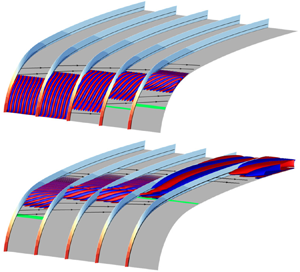Published online by Cambridge University Press: 23 February 2023

Linear stability analyses are performed to investigate the boundary layer instabilities developing in an incompressible flow around the whole leading-edge of swept ONERA-D and Joukowski airfoils of infinite span. The stability analyses conducted in our study are global in the chordwise direction and local in the spanwise direction. A neutral curve is drawn at a given leading-edge Reynolds number  $Re_R$ and several overlapping regions, called ‘lobes’, are identified on a physical basis. A detailed study of the marginal modes reveals the presence of attachment-line and cross-flow instabilities, as well as modes whose features do not fall within the standards of a specific type. Connected cross-flow/Tollmien–Schlichting modes, that show a dominant spatial structure reminiscent of Tollmien–Schlichting waves but whose destabilization is linked to a cross-flow mechanism, have been identified. The comparison of several neutral curves at different
$Re_R$ and several overlapping regions, called ‘lobes’, are identified on a physical basis. A detailed study of the marginal modes reveals the presence of attachment-line and cross-flow instabilities, as well as modes whose features do not fall within the standards of a specific type. Connected cross-flow/Tollmien–Schlichting modes, that show a dominant spatial structure reminiscent of Tollmien–Schlichting waves but whose destabilization is linked to a cross-flow mechanism, have been identified. The comparison of several neutral curves at different  $Re_R$ values reveals the greater stabilizing effect of the increase of
$Re_R$ values reveals the greater stabilizing effect of the increase of  $Re_R$ on the cross-flow instability compared with the attachment-line instability. The influence of the airfoil shape is also studied by comparing the neutral curves of the ONERA-D with the neutral curves of the Joukowski airfoil. These curves reveal similar characteristics with the presence of distinct lobes and their comparison at constant sweep angle shows that, under the conditions studied, the ONERA-D airfoil is more stable than the Joukowski airfoil, even for cross-flow instabilities. The absolutely or convectively unstable nature of the flow in the spanwise direction is also tackled and our results suggest that the flow is only convectively unstable.
$Re_R$ on the cross-flow instability compared with the attachment-line instability. The influence of the airfoil shape is also studied by comparing the neutral curves of the ONERA-D with the neutral curves of the Joukowski airfoil. These curves reveal similar characteristics with the presence of distinct lobes and their comparison at constant sweep angle shows that, under the conditions studied, the ONERA-D airfoil is more stable than the Joukowski airfoil, even for cross-flow instabilities. The absolutely or convectively unstable nature of the flow in the spanwise direction is also tackled and our results suggest that the flow is only convectively unstable.